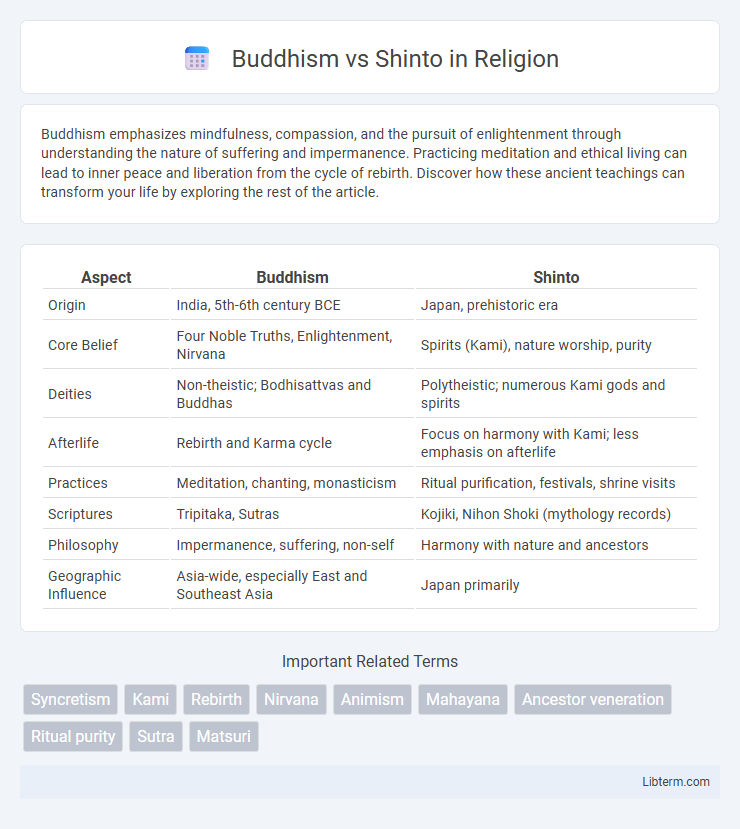Buddhism emphasizes mindfulness, compassion, and the pursuit of enlightenment through understanding the nature of suffering and impermanence. Practicing meditation and ethical living can lead to inner peace and liberation from the cycle of rebirth. Discover how these ancient teachings can transform your life by exploring the rest of the article.
Table of Comparison
| Aspect | Buddhism | Shinto |
|---|---|---|
| Origin | India, 5th-6th century BCE | Japan, prehistoric era |
| Core Belief | Four Noble Truths, Enlightenment, Nirvana | Spirits (Kami), nature worship, purity |
| Deities | Non-theistic; Bodhisattvas and Buddhas | Polytheistic; numerous Kami gods and spirits |
| Afterlife | Rebirth and Karma cycle | Focus on harmony with Kami; less emphasis on afterlife |
| Practices | Meditation, chanting, monasticism | Ritual purification, festivals, shrine visits |
| Scriptures | Tripitaka, Sutras | Kojiki, Nihon Shoki (mythology records) |
| Philosophy | Impermanence, suffering, non-self | Harmony with nature and ancestors |
| Geographic Influence | Asia-wide, especially East and Southeast Asia | Japan primarily |
Origins and Historical Background
Buddhism originated in the 5th to 6th century BCE in India, founded by Siddhartha Gautama, the Buddha, emphasizing enlightenment through meditation and moral living. Shinto, deeply rooted in ancient Japanese culture, predates written history and centers on kami worship, rituals, and connection to nature and ancestors. While Buddhism spread across Asia through missionaries and adapted into various sects, Shinto remained primarily indigenous to Japan, influencing its cultural and spiritual landscape.
Core Beliefs and Philosophies
Buddhism centers on the Four Noble Truths and the Eightfold Path, emphasizing the cessation of suffering through mindfulness, ethical conduct, and wisdom. Shinto focuses on kami worship, rituals, and harmony with nature, highlighting purity, reverence for ancestors, and the spiritual essence in all things. While Buddhism seeks enlightenment and liberation from the cycle of rebirth, Shinto prioritizes living in balance with the natural world and maintaining communal and familial bonds.
Major Deities and Spiritual Figures
Buddhism centers on spiritual figures such as Siddhartha Gautama (the Buddha), bodhisattvas like Avalokiteshvara embodying compassion, and arhats representing enlightened disciples. Shinto worships kami, which are spirits or deities including Amaterasu, the sun goddess, and Susanoo, the storm god, embodying natural forces and ancestral spirits. While Buddhism emphasizes enlightenment and the cycle of rebirth, Shinto focuses on ritual purification and harmonious relationship with nature and kami.
Rituals and Religious Practices
Buddhism emphasizes meditation, chanting sutras, and offering incense as core rituals aimed at enlightenment and karma purification. Shinto centers on rituals such as purification (misogi), offerings (shinsen), and festivals (matsuri) to honor kami spirits and maintain harmony with nature. Buddhist temples often serve as sites for ceremonies marking life transitions, while Shinto shrines host seasonal festivals that reinforce community bonds and spiritual connection.
Sacred Texts and Teachings
Buddhism centers around sacred texts such as the Tripitaka, Mahayana Sutras, and Tibetan Book of the Dead, emphasizing teachings on the Four Noble Truths and the Eightfold Path for achieving enlightenment. Shinto lacks a single canonical scripture but reveres ancient texts like the Kojiki and Nihon Shoki, which document kami deities, rituals, and mythology that guide followers in harmony with nature and ancestral spirits. While Buddhism focuses on personal liberation from suffering and rebirth, Shinto emphasizes ritual purity, community worship, and the veneration of kami to maintain balance and connection with the spiritual world.
Festivals and Holy Days
Buddhism observes festivals like Vesak, commemorating the Buddha's birth, enlightenment, and passing, while Shinto celebrates matsuri, seasonal festivals honoring kami spirits with rituals and offerings at shrines. Buddhist holy days often involve meditation, chanting, and temple ceremonies, contrasting with Shinto's emphasis on purification, dance, and community participation during festivals such as the New Year (Shogatsu) and Obon. Both traditions highlight the cyclical nature of life through their respective celebrations, reflecting deep cultural and spiritual values in Japan.
Symbols and Iconography
Buddhism prominently features the lotus flower, dharma wheel (Dharmachakra), and statues of the Buddha, symbolizing enlightenment, the path to spiritual awakening, and the Buddha's teachings. Shinto's iconography centers around torii gates, representing the transition from the profane to the sacred, and kamidana (miniature altars) that house kami (spirits), emphasizing reverence for nature and ancestral spirits. Both traditions use symbolism extensively, but Buddhism's icons convey philosophical and spiritual doctrines while Shinto's symbols highlight ritualistic and naturalistic elements.
Influence on Japanese Culture
Buddhism and Shinto have profoundly shaped Japanese culture, intertwining religious practices with traditional customs and festivals. Buddhist concepts of impermanence and meditation complement Shinto's reverence for nature and ancestor worship, influencing art, architecture, and rituals throughout Japan. The syncretism of these two belief systems is evident in historic temples, shrines, and ceremonies that continue to define Japanese cultural identity.
Roles in Contemporary Society
Buddhism provides a philosophical framework addressing suffering and enlightenment, influencing meditation practices and ethical conduct in contemporary societies worldwide. Shinto, rooted in Japanese culture, emphasizes rituals and reverence for nature and ancestors to foster community identity and social harmony. Both religions contribute uniquely to modern life by shaping cultural values, promoting mental well-being, and supporting traditional ceremonies.
Key Differences and Similarities
Buddhism, founded in the 5th century BCE by Siddhartha Gautama, centers on the Four Noble Truths and the Eightfold Path to achieve enlightenment and liberation from suffering, while Shinto, an indigenous Japanese religion, emphasizes kami worship, rituals, and harmony with nature. Both traditions coexist in Japan, influencing cultural practices and festivals, yet Buddhism focuses on spiritual development and the afterlife, whereas Shinto prioritizes purity, ancestor reverence, and the celebration of life. Shared elements include ritual practices, respect for sacred spaces, and the importance of meditation or prayer in daily life.
Buddhism Infographic

 libterm.com
libterm.com